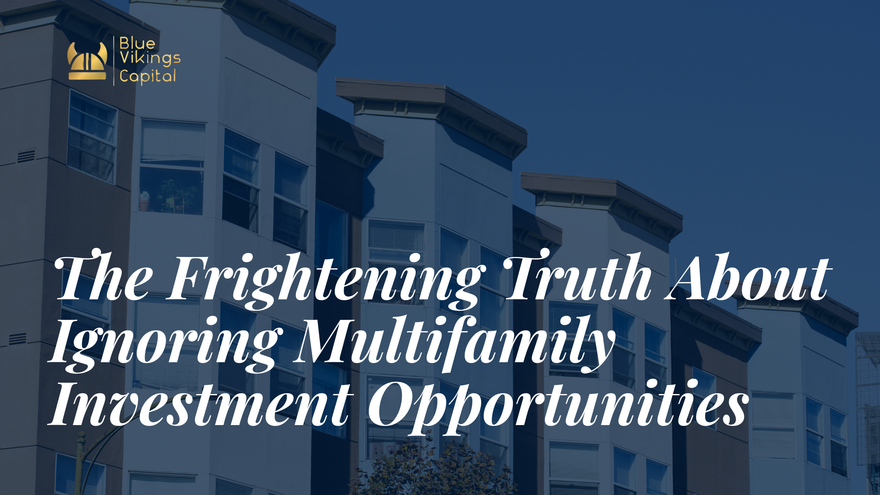The Frightening Truth About Ignoring Multifamily Investment Opportunities

Many people talk about real estate as a good way to build wealth, but few truly grasp what happens when they ignore opportunities in multifamily investments. The consequences can be painful: missed income, lost appreciation, and falling further behind. In this article, we’ll explore the hidden dangers of waiting, why multifamily real estate deserves your attention now, and what you risk by standing on the sidelines.
1. Lost Cash Flow That Could Have Been
One of the most immediate costs of ignoring an opportunity is lost cash flow. Multifamily properties generate rent income from multiple units each month. When you pass on a good deal, you let that stream of potential income slip by. Over time, those foregone cash flows compound—money not earned today is money that could have been invested elsewhere.
As rental demand remains strong in many markets, ignoring multifamily deals today may mean losing out on reliable income that others capture.
2. Missing Out on Property Appreciation
When market fundamentals are favorable, multifamily properties tend to appreciate over time. Appreciation happens for several reasons: rents go up, the income of the property increases, and investors are willing to pay more because they see growth ahead. Multifamily valuations are often tied to income. So if rent growth is healthy, the property’s value rises. By ignoring opportunities, you also ignore potential equity growth.
In many markets in 2025, while rent growth is moderate, scarcity of housing supply in some regions keeps upward pressure on values. Overlooking deals now means you might miss entering at lower price points before properties get more expensive.
3. Competitive Markets Move Fast
Real estate markets don’t wait. When an investor sees a strong opportunity, they act. If you ignore a good multifamily deal, chances are someone else will take it. By the time you return to look, either the deal is gone, or the price has moved upward. That means you end up buying later at higher prices or missing the best entry altogether.
This is especially true in hot growth areas and secondary markets where capital is flowing. Many of today’s top markets were less obvious just a few years ago. By ignoring them then, investors missed out. Waiting offers safer comfort—but also the risk of irrelevance.
4. Inflation, Rising Costs, and Barrier to Entry
Costs are rising. Materials, labor, land, regulations—they all get more expensive over time. Inflation makes the risk of waiting greater. If you delay investing, you’ll likely face higher acquisition costs, higher competition, and tougher underwriting metrics when entering later.
In multifamily markets, this effect is visible: as construction slows and supply tightens, the difference between buying earlier and buying later can be significant. Deals that seem marginal today might become out of reach tomorrow.
5. Higher Risk of Mistimed Timing
The longer you wait, the higher the chance that macroeconomic conditions will shift. Interest rates can rise, capital can become tighter, and financing terms can worsen. If you delay looking for good deals, you expose yourself to the risk of entering markets when conditions are less favorable.
In 2025, many forecasts expect rent growth to continue (but at a slower pace) and vacancy to creep upward in some markets. Buying at the wrong time in a weaker market can hurt your returns or even make investments unprofitable.
6. You Fall Behind in Wealth Building
Investing is about acquiring assets, growing them, reinvesting returns, and compounding growth. If you continually ignore opportunities, you miss years of compounding. Those additional years matter a lot for retirement, legacy, and financial freedom.
Other investors who act earlier have an advantage: more income, more appreciation, more deals to reinvest in. Standing still while others move forward puts you behind—not because you lacked skill, but because you missed timing windows.
7. Ignoring Trends Is Risky
Multifamily markets are evolving. Technology, demographic shifts, sustainability regulations, and migration patterns all influence which markets perform best next. If you ignore emerging markets or trends, you risk being stuck with underperforming assets.
For example, some markets are seeing large amounts of new supply, while others are limiting new development. Capital is shifting toward locations with limited supply and rising demand. Ignoring these trends means you might invest in markets that ultimately underperform.
What Happens If You Do Nothing
If you ignore multifamily opportunities:
- You lose monthly income potential
- You miss equity growth and compounding
- You let deals slip to competitors
- You enter later at higher costs
- You risk buying under weaker conditions
- You remain behind in building wealth
- You lose out on emerging trends
That is the frightening truth: doing nothing is a choice—and it has real costs.
What You Should Do Instead
- Educate yourself on market fundamentals and data
- Monitor emerging markets and early signals of opportunity
- Be ready with capital when a deal appears
- Partner with experienced operators who understand timing
- Act with discipline but decisiveness
At Blue Vikings Capital, we don’t chase every deal. We watch markets, analyze data, and position ourselves to act when the right ones appear. We invest passively alongside our investors. Declining or ignoring an opportunity that checks our criteria isn’t risk—it’s discipline. But ignoring too many good ones is a missed opportunity.
If you want help identifying deals now or understanding where the market is moving, I’m here—let’s talk.


0 comments
Leave a comment
Please log in or register to post a comment